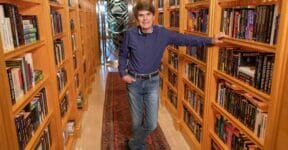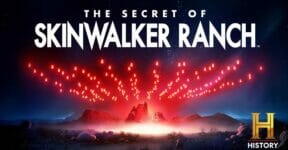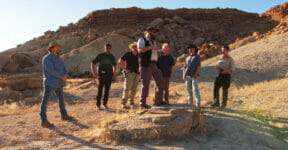A typical trait of many novels written by Dean Koontz is how the seemingly different narratives of multiple characters blend as the story closely reaches the end, added with some touches of sci-fi elements. In that regard, The Big Dark Sky falls right into his writing style.

The novel’s primary stage is the Rustling Willows Ranch in Montana. Joanna Chase used to live in the area until both her parents died, supposedly in an accident. For years following the tragedy, she relocated to her aunt’s place in Santa Fe. Now a grown-up woman, Joanna makes a living as a writer. For quite a while now, she has been experiencing a series of unusual occurrences like strange voices calling for her return and an actual phone message from someone named “Jojo” begging for her help. Joanna doesn’t know what to do with the persistent disturbances, but eventually, she gives in and takes a visit to her childhood home in Montana.
At around the same time as Joanna’s unexplained experiences, other strange things are happening to multiple individuals in various places:
- A billionaire named Liam O’Hara, the owner of Rustling Willows Ranch has just encountered an inexplicable disturbance during a visit. His family is terrified and now he is hiring a private detective, Wyatt Rider, to investigate the matter.
- Harley Spondollar, an allegedly embezzling chemist, still does not know why and how his house collapsed just moments after he had stepped outside.
- Jimmy Alvarez, a childhood friend of Joanna, is said to have been contacted by mysterious dark forces.
All of them are strangely drawn to an unknown person or entity on the remote ranch. Some are haunted by apparitions in the place or obsessed with it, while others simply cannot resist the temptation to solve the mysteries. Besides Joanna and Wyatt, there are also some hackers, a scientist and a few crazy brave people ready to confront whatever culprit that triggers the widespread and varied disturbances. Think of them as a group of oddball heroes on a daring venture against an unknown villain.
More depressing news concerns Asher Optime, a former associate of Xanthus Toller’s Restoration Movement, who is determined to eliminate humans to bring back the balance of nature. He has kidnapped and murdered five people so far. He is a true madman hellbent on doing whatever it takes to save the future of the world, even if it requires him to get rid of humanity itself from the planet. Unless the oddball heroes can work together as a team to stop Optime, there will be no future for everyone.
Considering the number of characters, each with their own background story, the novel promises an extra dose of plotline intricacies. The Big Dark Sky is a real page-turner; not only because of its colorful cast that forces you to keep up with the interpersonal relationship but also the extent of tiny details on just about every page. There is everything imaginable in the story from aliens and monsters to quantum mechanics and the looming danger of an apocalypse.
The evil entity at Rustling Willows eventually gets everybody’s attention all the same, even if it attracts them in different fashions. You might feel like being bombarded with information and rapid plotline progression in the early parts of the novel, which probably is a good thing to take you into an adventurous mood. The progression hits the brake and slows down as the narrative takes turns to explore the characters’ journeys, leading to the eventual gathering in Rustling Willow. At least from one character’s viewpoint, all the events entangle with each other and end up in an Agatha Christie reveal moment.
Synchronicity is The Big Dark Sky’s big keyword. According to the online Cambridge Dictionary, it refers to the occurrence of two or more similar/related events at the same time by mere chance. The novel takes a full extent of the definition to build a foundation for the story. The strange phenomenon happening to the characters and the circumstances that lead them to Rustling Willow are in perfect sync to drive the unique personalities into arriving at the same conclusion. It is not an uncommon phenomenon in many novels and films, but Dean Koontz’s multi-strand narratives are so effective that everything barely feels like a coincidence. In fact, for more than a few times, the novel wants to make sure that you notice the synchronicity as it explains the intricate connections among the characters.
Keen sci-fi readers should also easily spot some pop culture references to Koontz’ own books and homage to the works of prominent writers such as Ray Bradburry and Isaac Asimov. Such references may be regarded as early hints of the mystery being unveiled.
We think The Big Dark Sky is indeed a big and dark book. It is an enjoyable mix and match of such various genres as thriller, sci-fi, action and some supernatural elements, too. As far as the “dark” part is concerned, some pages offer intense gruesome, which seems at odds with Koontz’ usual approach but is still under a healthy dose that it doesn’t take over the writer’s style to an overwhelming degree. It might not a story that you need to take seriously and yet it remains an outright enjoyable read.
Do you find The Big Dark Sky an easy-read or confusing with that number of characters involved? Can you name other novels with similar premise and story? We’d love to hear from you.
Other things you might want to know:
What is regarded as Koontz’s style or genre?
Dean Koontz’ works typically fall under “suspense thriller” category although it is not uncommon for his stories to have touches of sci-fi, satire, mystery, and horror. Throughout his long career, Koontz has published over 105 novels and sold over 450 million copies.
Popular screen adaptations of Koontz’ works:
- Demon Seed (1977) – based on Demon Seed (1973)
- The Passengers (1977) – based on Shattered (1973)
- Watchers (1988) – based on Watchers (1987)
- Watchers II (1990) – based on Watchers (1987)
- The Face of Fear (1990) – based on The Face of Fear (1977)
- Watchers 3 (1994) – based on Watchers (1987)
- Hideaway (1995) – based on Hideaway (1992)
- Intensity (1997) – based on Intensity (1995)
- Mr. Murder (1998) – based on Mr. Murder (1993)
- Phantoms (1998) – based on Phantoms (1983)
- Watchers Reborn (1998) – based on Watchers (1987)
- Sole Survivor (2000) – based on Sole Survivor (1997)
- Black River (2001) – based on short story Black River (2000)
- Odd Thomas (2013) – based on Odd Thomas (2003)
Koontz’s popular novel series:
Moonlight Bay Series
- Fear Nothing (1998)
- Seize the Night (1999)
- Ride the Storm (not published yet)
Frankenstein Series
- Prodigal Son (2005)
- City of Night (2005)
- Dead and Alive (2009)
- Lost Souls (2010)
- The Dead Town (2011)
Odd Thomas Series
- Odd Thomas (2003)
- Forever Odd (2005)
- Brother Odd (2006)
- Odd Hours (2008)
- Odd Interlude (2012)
- Odd Apocalypse (2012)
- Deeply Odd (2013)
- Odd Thomas: You Are Destined to Be Together Forever (2014)
- Saint Odd (2015)
Check out other articles by month:







